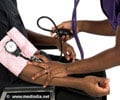Blood pressure of above 120 could be desirable for patients with diabetes and coronary artery disease, suggest US researchers.
Blood pressure of above 120 could be desirable for patients with diabetes and coronary artery disease, suggest US researchers.
The International Verapamil SR-Trandolapril study, known as INVEST, suggests that the range considered normal for healthy Americans may actually be risky for those with a combined diagnosis of diabetes and coronary artery disease.The INVEST study is the first to evaluate the effects of blood pressure-lowering in diabetic patients diagnosed with coronary artery disease. University of Florida researchers analyzed data collected from 6,400 patients from fall 1997 to spring 2003. The patients, who were 50 or older, were recruited from more than 850 sites in 14 countries. The researchers further consulted the national death index for U.S.-enrolled patients for an additional five years to compare death rates of patients based on their blood pressure category ranging from tightly controlled to non-controlled hypertension.
Based on hypertension treatment guidelines, health-care practitioners have assumed that with regard to blood pressure, "the lower, the better." But systolic levels between 130 and 140 appear to be the most healthful, the INVEST study seems to suggest.
The data show an increased risk of heart attack, stroke or death for patients having blood pressure deemed too high -- or too low, according to Rhonda Cooper-DeHoff, Pharm.D., an associate professor of pharmacy and medicine at UF.
Reporting her findings Sunday at the American College of Cardiology's 59th annual scientific session in Atlanta, Rhonda Cooper-DeHoff, Pharm.D., an associate professor of pharmacy and medicine at UF, said, “Our data suggest that in patients with both diabetes and coronary artery disease, there is a blood pressure threshold below which cardiovascular risk increases."
As many as two out of three adults with diabetes have high blood pressure. Normal blood pressure as defined by the American Heart Association is less than 120 systolic and less than 80 diastolic. Blood pressure greater than 140 is still associated with a nearly 50 percent increase in cardiovascular risk in patients with diabetes. But efforts to reduce systolic blood pressure to below 130 did not appear to offer any additional benefit to diabetics with coronary artery disease compared with reduction of systolic blood pressure to between 130 and less than 140.
Advertisement
Stephan Brietzke, M.D., an endocrinologist who did not participate in the research, was intrigued by the findings, saying that they parallel recent studies looking at blood sugar control, which suggest a U-shaped curve with higher cardiovascular risks at both "too high" and "too low" extremes.
Advertisement
"Identifying thresholds of when to initiate treatment, and when to say 'good enough,' is extremely important not only to optimize patient outcomes, but also to help reduce unnecessary costs of care," Brietzke said.
The AHA reports that heart disease or stroke is the top cause of death for people with diabetes, affecting more than 60 percent of patients. High blood pressure, common in diabetes, doubles the risk of cardiovascular disease.
Source-Medindia
GPL














